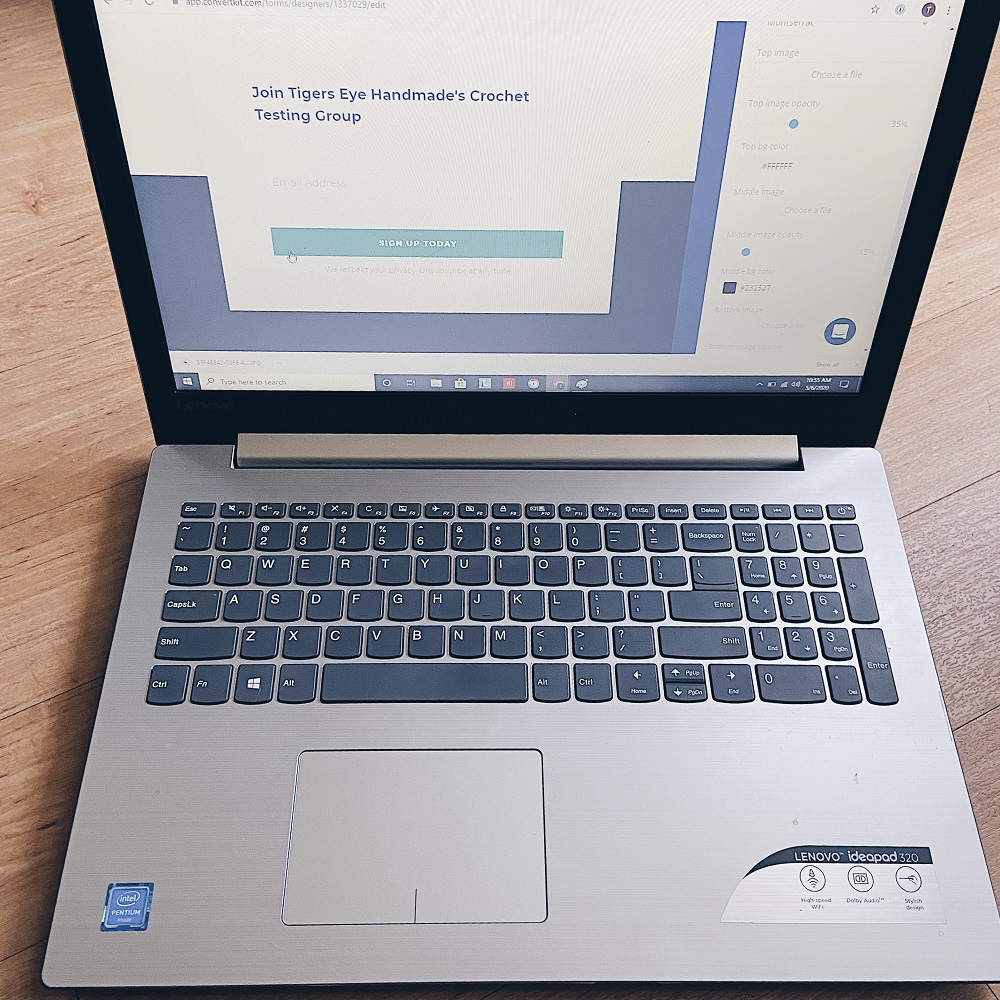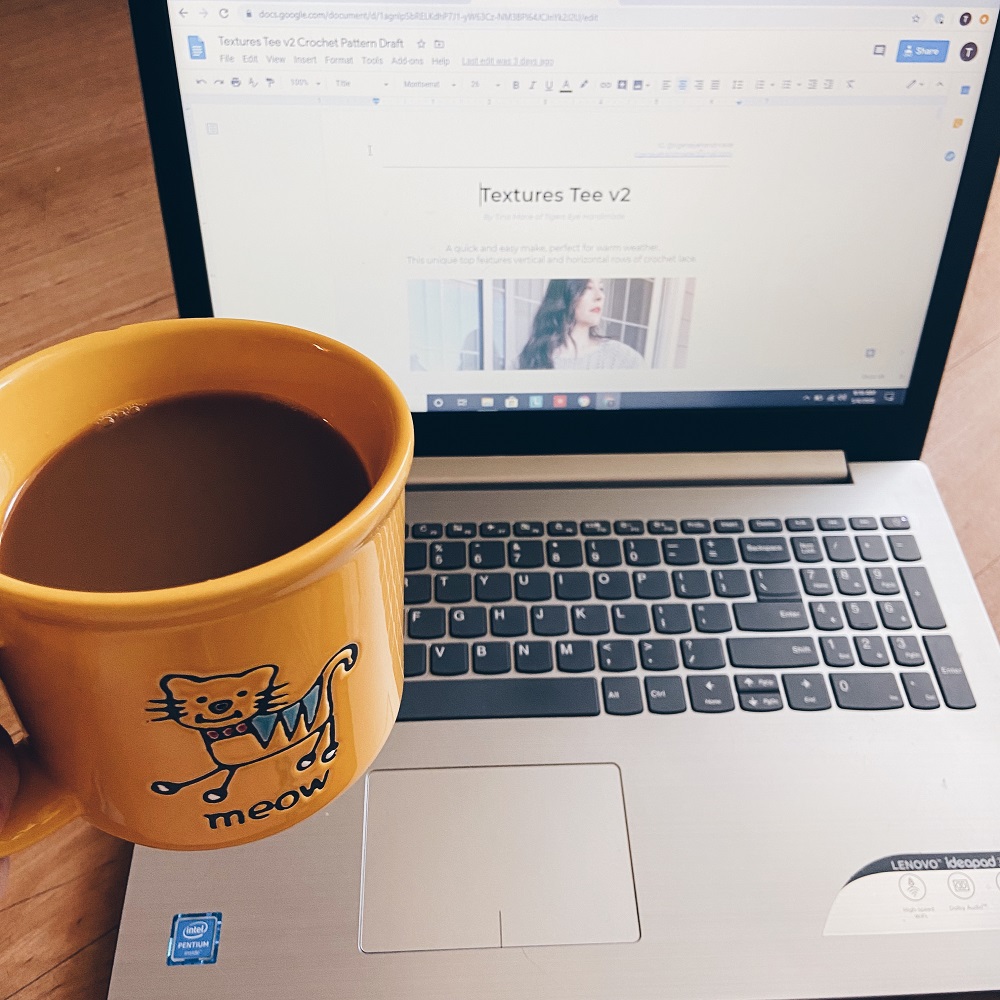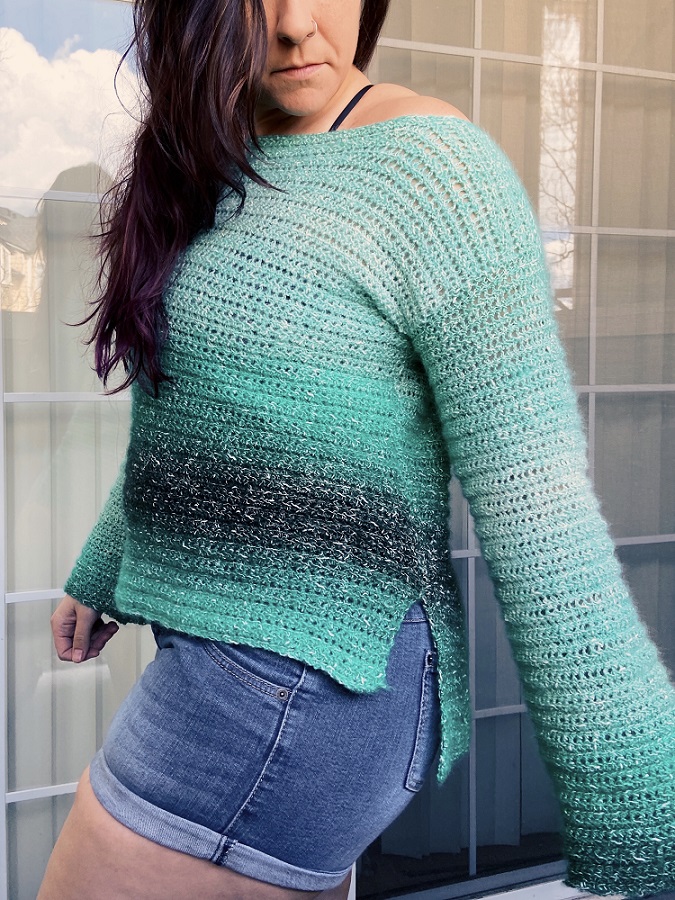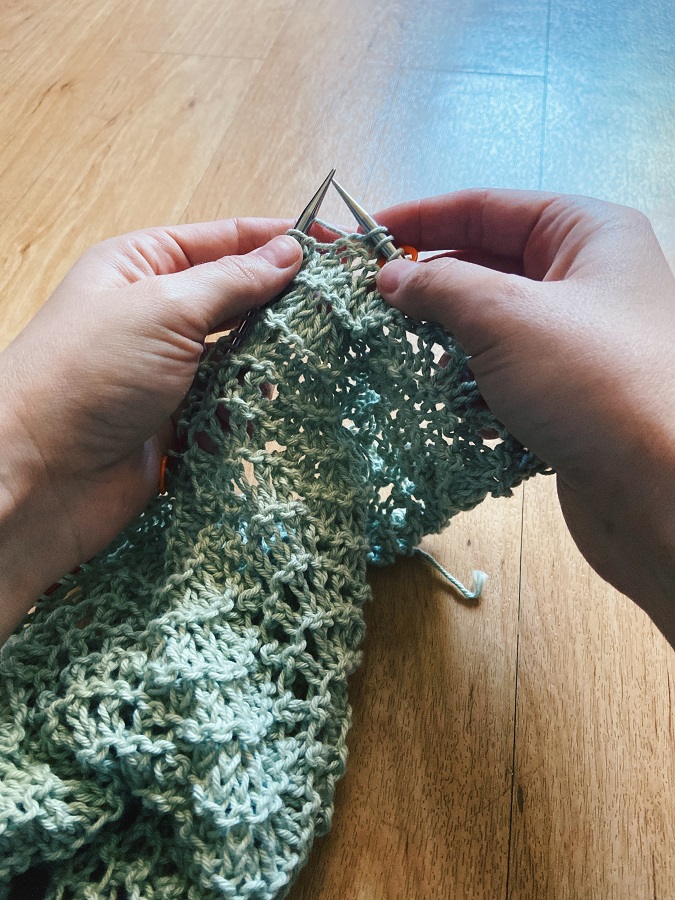Running your first test is wonderful and EXCITING! But… it can also be extremely nerve-racking to release your idea and creation out into the world. I remember feeling horrified to start the testing process with my first few garment designs. It was to the point where I almost didn’t continue pursuing crochet design. I remember sort of flailing around as I checked and re-checked over the pattern wondering if all the math was right. I wondered if it would work for every size and was so afraid of making mistakes.
Then there was the whole idea of actually running the crochet test. First off, I was afraid that no one would want to test my designs. Secondly, I wasn’t even sure HOW to find testers. I’d only very recently created my fiber arts-focused Instagram around the same time that I made my first design. At that time, I had very few connections in the fiber arts world.
If you’re a new designer and are having similar feelings/struggles, but you’re willing to push through it, then keep on reading. I’m going to share about my own testing process. I’ll also share some resources that I REALLY wish I’d known about when I was just beginning.
1. Finding Testers
Tester Email List
My current process involves a few different steps. Very recently, I created a tester email list, with the sole purpose of sharing my testing calls. This is always the first place that I post a pattern test. The email list is a great option for people who are specifically interested in becoming a tester. They can sign up to be the first to hear about opportunities.
Often, there is a better chance that people will see an email compared with a post on social media. When I only posted testing calls to IG, there were quite a few instances where people saw the post after it was too late. The spots were already filled, and they were disapointed. The Instagram algorithm doesn’t always show you posts from ALL the people that you follow; it shows you posts from the people you engage with most. That can make it tough to reach all possible people that may be interested in testing.

Tester Calls on Instagram
Of course it may take time to find people to sign up for your tester email list. If you don’t have an email list yet, you can find testers on Instagram.
- Post a picture of the item to be tested on my IG feed, and share it in my stories. There’s some great hashtags to help crochet testers find your post. Some examples are #crochettestercall #crochettesterswanted and #crochettest. If it’s for a knitwear design, you can replace the word ‘crochet’ with ‘knit’ in your hashtags. I usually re-post to stories once a day or so. I’ll add the link to a Google Form application in my profile (using linktr.ee).. If you need help creating your application, there are tons of examples online if you google “crochet test application”.
- Share the testing call to https://www.instagram.com/fattestknits IG page- they are an amazing resource for size inclusive design. They have instructions for how to submit your test in their highlights.
- Share the testing call to a Facebook group.
Facebook Testing Groups
If you don’t have a lot of connections on Instagram yet, Facebook groups can be a great way to find test crocheters (or knitters). Initially, I found ALL my testers using Facebook groups. The best group so far (for me) has been a group called Pattern Testers: https://www.facebook.com/groups/patterntesters/
This is a dedicated group for designers and testers to connect. They have excellent standards which must be upheld to maintain membership in the group. All posts are submitted for review first before being shared. They have a super handy link to a google form where you add in all the information about the test. Whether it’s knit or crochet, what type of item, sizing, materials including amount of yarn needed, and so on. Once you enter your information into the Google Form, you hit submit, then it can be copied and pasted onto their Facebook group wall for review.
Pattern Testers are also on Instagram, but mainly for sharing design releases. https://www.instagram.com/pattern.testers/
Before you put out the testing call, it’s good to have an idea of how many testers you want (per size for garments). Then, as you are getting applications in you can determine if you need to re-share your post again and network a bit more to bring in more applicants.
2. Choosing Your Testers
Hopefully after sharing your testing call out to the world, you’ll have a some applications in within a few days. Now it’s time to make selections and build your team!
For me, this is the hardest part of the whole testing process. To make it a bit easier, I try to monitor the applications so if quite a few come in for particular size (and they are strong candidates). When a size fills up, I’ll remove that size from the application.
At minimum, I would recommend choosing at least two testers per size. If you’ve designed a piece that has options for customization, then I think 3-4 testers per size is even better. It is always good to have MORE than you need, in case someone is not able to complete the test. And that is likely to happen, more on that later…
Honestly, when you are just starting out, I think it is a good idea to have MANY testers per size. The more people you have testing your item, the more feedback you will get, and the more connections you will make! This will help you build community and grow.
How I choose:
- Experience: It depends on the level of the pattern. In most cases, I select people with a wide variety of experience to see if my pattern is accessible to beginners and on. If it’s an intermediate/advanced level pattern, then I may try and pick more experienced testers.
- Attention to detail & ability to follow directions: You can tell a lot about this through the application process. For example, is the applicant answering your questions fully? Are they asking you questions about the test that could be answered by reading the pattern details provided in the application?
- First impression: I request that applicants have a public IG account. Through reading their application, and checking out their feed, I get a feel for what the person is about… I try to keep it simple and go with my gut.
- Photography & work samples: I look for neat work and consistent tension. Good, clear photos are a major bonus.
If you can’t find enough testers, not to worry. This has happened to me a few times, for a particular size or two. In some cases, I was able to find testers after the test has started, and I just gave them an extended deadline.
In cases where I wasn’t able to find a tester for a particular size, I released the pattern and included a note on the pattern page like this:
“Size 8 has not been tested. If this is your size, and you‘re willing to provide pattern feedback and photos, please contact me about receiving the pattern for free. “
I think it’s fair to offer this option for any size that hasn’t gone through the testing process.
3. Hosting Your Test
Once I’ve made my selections, I notify the chosen testers through a welcome email. In the email, I’ll lay out expectations for the test including the due date, group chat rules, and the link to the pattern feedback form. I DO NOT share the pattern PDF in the welcome email anymore, after being “ghosted” a couple times. I ask the testers to reply to the email ASAP to let me know that they have read and agree. THEN I add them to a group chat where I share the PDF link to a Google Doc of the pattern draft.
Instagram Group Chat
You could host your test a number of different ways. My preferred method is using IG group chat. IG is where I hang out most, and I am most comfortable. You can have a maximum number of 32 people using this feature. This has been more than sufficient for me, and I have never needed more than that for a given project.
Facebook Group/ Messenger
If you have a garment that is sized from infant through adult, and you need more than 32 testers, you can create a private Facebook Group. Or you can use Facebook Messenger which can host up to 250 people in one group.
My first test group chat took place on Facebook Messenger. It worked out fine, except every time someone made a new comment, it would automatically scroll down to the new message. This was majorly annoying for anyone who was trying to go back and read something because they’d lose their place.
Ravelry
Ravelry is another option for hosting a test. You can create your own group and use the forums. I have never tried this method, but it seems like it could be a good way to go if you are comfortable with the platform.
4. Working Through Issues During Testing
No matter how many times you go through your pattern, how great your math is, or how amazing your testers are… there still may be hiccups along the way.
Sizing

Even when using the Craft Yarn Council Standards, there can be issues with sizing. People have unique shapes and sizes as well as differing proportions. When testers run into problems with sizing, it helps me to figure out what modifications should be included. I try to add notes in my pattern with instructions to adjust the length or shape to help with this.
Readability
Besides issues with sizing and fit, testing is a great way to see if the way you have written the pattern is working for others. Sometimes what makes perfect sense to you may not make sense for others. I tend to use abbreviations and then forget to list them in the pattern techniques and abbreviations list in the very beginning of the pattern. This can be confusing, especially for those for whom the language that the pattern is written in isn’t their first language.
Always thank your testers when they find a mistake. Even if i’s their own error, maybe there is something that you can explain better within the pattern. I have been a crochet tester in groups where the designer has gotten defensive and argumentative over issues in their pattern. It was so off-putting. Testers are volunteering their time, and have paid for their own materials to help you with your pattern. Be gracious for their help.
5. Completing the Test
Around the time of your due date is such a fun time because FO (finished object) pictures are starting to be shared. One of my favorite parts of testing is seeing everyone’s versions of the design that started as a little idea in my head. IT’S SO COOL!
Compensation
It is up to you if you want to offer a gift to each tester for their commitment and efforts. I like to gift a bonus pattern to testers that finish on time and provide feedback and pictures as promised. If the test was for your first pattern, you could offer a credit for a future pattern instead.
Deadline Extensions & Failure to Finish
When testers are not able to finish on time, hopefully they’ve been in good communication with you to let you know what is going on and ask for an extension. I’m usually okay with this, as lo I don’t have any deadlines with pattern releases at this point, and this is something I am doing for fun.
Though sadly, for every test I have done, there has been at least one person who didn’t finish, and/or “disappeared”. This can feel super disappointing, but I try not to get too down about it. I have no idea what their life circumstances are, so I try not to take it personally.
At this point, when someone doesn’t finish (and if they haven’t been in communication), the day after the due date I will message them to check in to ask how they are doing, and see when they will be finished. Sometimes this works and they are few days late, and sometimes they don’t respond.
There’s some options to help prevent this situation. You can make a statement stating that those who don’t finish will be invoiced the cost of the pattern. This should be included in both in your application and welcome email. This way anyone who volunteer has to agree to the terms before starting on the test. It’s your call on whether you want to take this route. Testing is a voluntary agreement. You may choose to give people the benefit of the doubt. Maybe you can have flexible terms if they have good communication and reason for missing the deadline. We don’t always know what folks are facing in life. And who’s to say they have to pay anyway?
If you have issues with a person that is part of the Facebook Pattern Testers Group, notify the group moderators. They’ll put the person on probation or remove them from the group depending on the circumstances and their history. The moderators are great resources for help around issues in your pattern test. I am grateful to them for their time and effort in helping both designers and testers have a good experience.
Testing is AWESOME!
I’ve had an amazing experience with the majority of the testers I’ve worked with. It’s such an amazing way to make friends in the fiber arts community.
With every test that I’ve hosted, I’ve learned so much. Each test has been even better than the last. I think it is important to go into testing with a “growth mindset”. No matter what happens, there is something to learn from.
It is so fun to share ideas and then see other people’s interpretations of your idea. I am so glad that I went for it, even thought it was super scary at first. I hope that you’ll go for it too!
Are you READY?
Maybe you won’t be ready until you’re actually doing it. That’s kind of how it was for me. But it was SO WORTH IT!
I’d love to know about your thoughts on testing. If you’ve gone through the process, how did it go? OR If you haven’t hosted a test just yet, how are you feeling about it all??


 The Ocean Pullover: Free Crochet Sweater Pattern
The Ocean Pullover: Free Crochet Sweater Pattern